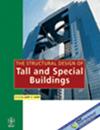钢-混凝土组合梁火灾力学性能的数值分析
IF 1.3
3区 工程技术
Q3 CONSTRUCTION & BUILDING TECHNOLOGY
引用次数: 2
摘要
本文通过数值分析研究了钢-混凝土组合梁(SCB)和部分外包钢-混凝土复合梁(PEB)的火灾行为。用ABAQUS软件建立的数值模型与实验结果进行了对比验证。通过参数研究,研究了荷载比、混凝土和钢材强度、混凝土板宽度、钢梁尺寸、防火层和剪力连接程度对SCB和PEB火灾性能的影响。分析结果表明,SCB和PEB在火灾下的变形阶段都经历了弹性、弹塑性、塑性小变形和塑性大变形四个阶段。SCB的腹板在火灾下经历拉伸-压缩-拉伸过程,PEB的底部翼缘甚至可能在较低的载荷比下从拉伸变为压缩。PEB的破坏模式,即混凝土是否被压碎,取决于荷载比。当SCB失效时,混凝土被压碎,只有钢梁的底部翼缘屈服。在各种参数下,SCB的耐火极限约为22 min,而PEB的耐火性为82–93 在0.4的负载下。当荷载比从0.2增加到0.6时,SCB的耐火性降低了8min,而PEB的耐火性能降低了110 min.在正常使用荷载比为0.4的情况下,为了满足一级耐火等级,仍需要对PEB采取额外措施,SCB的钢梁需要至少15mm的防火层。最后,考虑到温度内压,引入了与火灾时间相关的系数,对SCB和PEB的极限抗弯承载力公式进行了修正,结果表明,该公式具有良好的准确性。本文章由计算机程序翻译,如有差异,请以英文原文为准。
Numerical analysis on mechanical behavior of steel‐concrete composite beams under fire
This paper investigated the fire behavior of steel‐concrete composite beams (SCB) and partially encased steel‐concrete composite beams (PEB) through numerical analysis. The numerical models established by the software ABAQUS were verified against experimental results. Parametric studies were performed to study the influences of load ratio, strength of concrete and steel, width of concrete slab, size of steel beam, fire protection layer, and degree of shear connection on the fire behavior of SCB and PEB. The analysis results show that the deformation stages of SCB and PEB under fire both go through four stages: elastic, elastic–plastic, plastic small deformation, and plastic large deformation. The web of SCB experiences a tension–compression–tension process under fire, and the bottom flange of PEB may even change from tension to compression at a lower load ratio. The failure mode of PEB, whether the concrete is crushed, depends on the load ratio. When SCB fails, the concrete is crushed and only the bottom flange of the steel beam yields. Under various parameters, the fire resistance of SCB is about 22 min, while the fire resistance of PEB is 82–93 min under a load of 0.4. When the load ratio increases from 0.2 to 0.6, the fire resistance of SCB decreases by 8 min, while that of PEB decreases by 110 min. To meet class I fire resistance rating under a normal service load ratio of 0.4, additional measures for PEB are still required, and at least 15 mm of fire protection layer is required for the steel beam of SCB. Finally, considering the temperature internal fore, a coefficient related to the fire time was introduced to modify the formula of ultimate flexural capacity of SCB and PEB, which showed good accuracy.
求助全文
通过发布文献求助,成功后即可免费获取论文全文。
去求助
来源期刊
CiteScore
5.30
自引率
4.20%
发文量
83
审稿时长
6-12 weeks
期刊介绍:
The Structural Design of Tall and Special Buildings provides structural engineers and contractors with a detailed written presentation of innovative structural engineering and construction practices for tall and special buildings. It also presents applied research on new materials or analysis methods that can directly benefit structural engineers involved in the design of tall and special buildings. The editor''s policy is to maintain a reasonable balance between papers from design engineers and from research workers so that the Journal will be useful to both groups. The problems in this field and their solutions are international in character and require a knowledge of several traditional disciplines and the Journal will reflect this.
The main subject of the Journal is the structural design and construction of tall and special buildings. The basic definition of a tall building, in the context of the Journal audience, is a structure that is equal to or greater than 50 meters (165 feet) in height, or 14 stories or greater. A special building is one with unique architectural or structural characteristics.
However, manuscripts dealing with chimneys, water towers, silos, cooling towers, and pools will generally not be considered for review. The journal will present papers on new innovative structural systems, materials and methods of analysis.

 求助内容:
求助内容: 应助结果提醒方式:
应助结果提醒方式:


